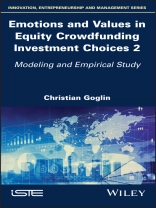Equity crowdfunding is a new way for seed stage start-ups to
generate initial capital and, as such, raises questions around the
choices made by investors within this area. Understanding it is
important for investor protection, as investors are generally
unaware of the factors that can influence their decisions.
However, investing in equity crowdfunding places the investor in
a unique decision-making framework, in which resources such as
images, videos and storytelling are all mobilized by entrepreneurs
and platforms as tools of persuasion. This context thus seems to
favor more holistic and emotional decision-making, rather than a
process that is rational and analytical.
Volume 1 presents a transdisciplinary theoretical analysis,
combining different fields within the social sciences, primarily
finance, marketing and psychology. In this second volume, an
explanatory model is developed on the basis of this theoretical
framework, which is then empirically tested using data from
laboratory experiments. This book also proposes the original
theory of emotional matching , which is both justified and
substantiated. It personalizes behavior and offers a new
perspective based on project characteristics and investor
preferences.
Inhaltsverzeichnis
Introduction ix
Chapter 1. Modeling: The Explanatory Model and the Individual Predictive Model 1
1.1. Preliminary assumptions 1
1.1.1. Nature of uncertainty 1
1.1.2. Consequentialism 3
1.1.3. Rationality of the equity crowdfunding investor: a triptych of rationality 4
1.2. Explanatory model 8
1.2.1. Choice of model variables by the combined hypotheticodeductive and inductive/abductive approach 9
1.2.2. Confirmatory study of the variables of the model on qualitative material 21
1.2.3. Operationalization: development of the measurement model, choice, adaptation of scales and return to data 35
1.2.4. Other hypotheses of the model 73
1.2.5. Reading grids for the explanatory model 83
1.2.6. Conclusion 89
1.3. Individual predictive model 90
1.3.1. Presentation 90
1.3.2. Affective matching theory 93
1.3.3. Theoretical foundations 97
1.3.4. Definitions and operationalization 99
1.3.5. Concluding remarks 107
1.4. Conclusion 108
Chapter 2. Experimentation 109
2.1. Experimental protocol 109
2.1.1. Rationale and objectives 111
2.1.2. Constitution, sample size and recruitment procedure 114
2.1.3. Experimental protocol 117
2.1.4. Experimental design 121
2.1.5. Conclusion 124
2.2. Carrying out the experimental procedure 125
2.2.1. Conducting the experimental procedure 125
2.2.2. Conclusion 128
2.3. Validity and handling of biases 128
2.3.1. Validity 128
2.3.2. Handling biases 129
2.3.3. Concluding remarks 131
2.4. Conclusion 131
Chapter 3. Hypotheses Testing, Results and Discussion 133
3.1. Data prerequisites and the PLS approach 133
3.1.1. Statistical data of the sample 133
3.1.2. PLS-SEM 134
3.1.3. Corrective reprocessing, transformation and adding control variables to the data file 135
3.1.4. Sample size 136
3.1.5. Data review: completeness and data quality 136
3.1.6. Indicator measurement scales: symmetry and equidistance 138
3.2. Preliminary validity of the measurement model 138
3.2.1. Review of the measurement model 138
3.2.2. Single-indicator variables 142
3.2.3. Reflective variables 143
3.2.4. Formative variables 178
3.2.5. Conclusion 191
3.3. Estimation of the explanatory model by structural equations 193
3.3.1. PLS-SEM approach 193
3.3.2. Revision of the structural model 195
3.3.3. Structural model 195
3.3.4. Mediators 214
3.3.5. Invariance and moderators 223
3.3.6. Control variables 247
3.3.7. Conclusion 250
3.4. Experimental design 250
3.4.1. Impact of the Quality of the Business Plan on the Perceived Signal Quality 251
3.4.2. Effect of the business plan on the parameters estimated by multigroup analysis 255
3.4.3. Conclusion 256
3.5. Results of the individual predictive model 259
3.5.1. Reminder of the model 259
3.5.2. Results of the individual predictive model 270
3.5.3. Conclusion 279
3.6. Conclusion 280
Conclusion 283
References 309
Index 339
Über den Autor
Christian Goglin is a Doctor of Management Sciences and a
research associate at the CREGO Laboratory, part of the
University of Burgundy ? France-Comte, France. His research and
academic publications focus on behavioral finance and financerelated investor choice.












